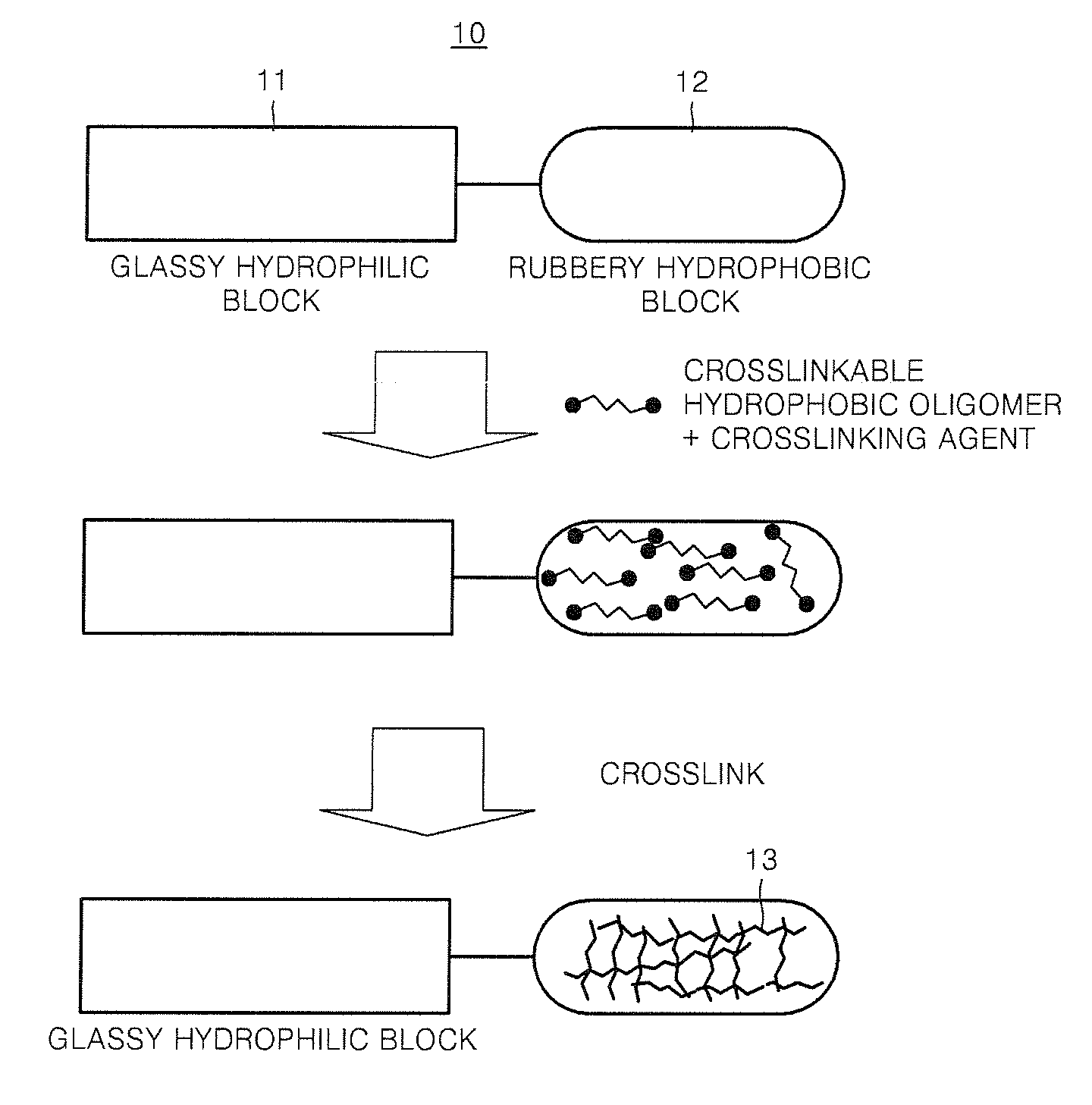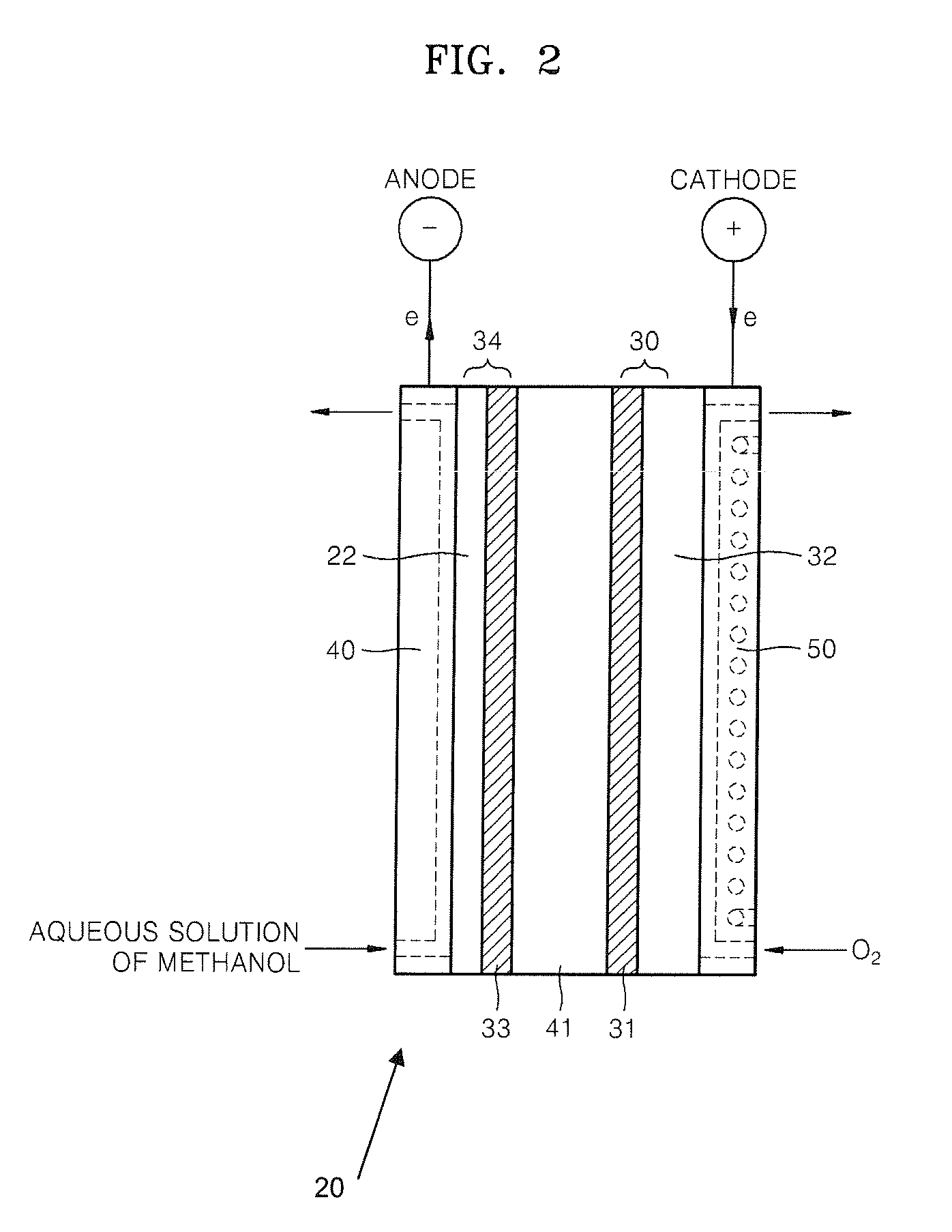Composition containing proton-conductive copolymer, polymer electrolyte membrane, method of producing the membrane , and fuel cell using the membrane
- Summary
- Abstract
- Description
- Claims
- Application Information
AI Technical Summary
Benefits of technology
Problems solved by technology
Method used
Image
Examples
synthesis example 1
Production of Proton-Conductive Block Copolymer
[0078]
[0079]In a nitrogen atmosphere, 2 g of the styrene-dimethylsiloxane block copolymer of Formula (5) (wherein m is 0.7; r is 0.3; and n is about 170; the weight average molecular weight is 159,000) was added to 20 g of dichloroethane, and the mixture was refluxed at 50° C.
[0080]Acetic anhydride and 98 wt % sulfuric acid were mixed, at a mixing ratio by mole of 2:1, to yield acetyl sulfate.
[0081]0.8 g of the acetyl sulfate was added drop-wise to the reflux mixture, and the resultant mixture was refluxed at 60° C. for 3 hours. Then, 2-propanol was added to terminate the reaction, and the solvent was removed from the reaction mixture by evaporation. The residual product was washed with water and methanol, to obtain a proton-conductive block copolymer represented by the Formula (4) above (p=0.22, q=0.48, r=0.3 and n=170).
example 1
Production of Polymer Electrolyte Membrane
[0082]1 g of the proton-conductive block copolymer of Formula (4) (p=0.22, q=0.48, r=0.3 and n=170) obtained in the Synthesis Example 1 was dissolved in 20 g of tetrahydrofuran, and the mixture was stirred to obtain a solution A.
[0083]Apart from this, 1 g of a siloxane oligomer represented by Formula 7 (m=about 200) and 0.1 g of a cross-linking agent represented by Formula II (k=about 192, t=about 8) were dissolved in 20 g of tetrahydrofuran, to obtain a solution B.
[0084]The solution A and the solution B were mixed, at a mixing ratio by weight of 19:1, to yield a composition C.
[0085]The composition C was placed on a glass dish and left to stand at 20° C., for 4 hours under a nitrogen stream (0.1 liter / min), to form a film, and the film and the glass dish were heated at 70° C. for 12 hours to induce a cross-linking reaction between the siloxane oligomer and the cross-linking agent. Thus, a polymer electrolyte membrane comprising the proton-co...
example 2
Production of Polymer Electrolyte Membrane
[0086]A polymer electrolyte membrane was formed, according to the same method as in Example 1, except that the solution A and the solution B were mixed at a mixing ratio by weight of 9:1, to obtain a composition D.
PUM
| Property | Measurement | Unit |
|---|---|---|
| Temperature | aaaaa | aaaaa |
| Percent by mass | aaaaa | aaaaa |
| Percent by mass | aaaaa | aaaaa |
Abstract
Description
Claims
Application Information
 Login to View More
Login to View More - R&D
- Intellectual Property
- Life Sciences
- Materials
- Tech Scout
- Unparalleled Data Quality
- Higher Quality Content
- 60% Fewer Hallucinations
Browse by: Latest US Patents, China's latest patents, Technical Efficacy Thesaurus, Application Domain, Technology Topic, Popular Technical Reports.
© 2025 PatSnap. All rights reserved.Legal|Privacy policy|Modern Slavery Act Transparency Statement|Sitemap|About US| Contact US: help@patsnap.com



